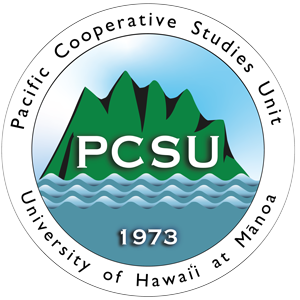 DEPARTMENT OF LAND AND NATURAL RESOURCES
DEPARTMENT OF LAND AND NATURAL RESOURCES
DAVID Y. IGE
GOVERNOR
CARTY CHANG
ACTING CHAIRPERSON
FOR IMMEDIATE RELEASE
February 23, 2015
HAWAII’S TOP TEN INVASIVE SPECIES HIGHLIGHTED DURING ANNUAL WEEK
Focus on Environmental & Economic Impacts of Invasives
HONOLULU – Little fire ants, coconut rhinoceros beetles, albizia trees, rats, mongoose, strawberry guava, coqui frogs, miconia, fireweed and invasive algae all share one common trait. As invasive species, they provide examples of some of the worst offenders among the many plants and animals that pose what the state legislature has declared as “the single greatest threat to Hawaii’s economy, natural environment and to the health and lifestyle of Hawaii’s people.” Hawaii’s isolation has made our island state home to more invasive species than anywhere else in the U.S.
During the 3rd annual Hawaii Invasive Species Awareness Week (HISAW), the Hawaii Invasive Species Council (HISC) and the state agencies charged with combatting and controlling invasive species, will again share information and engage people across the state to raise awareness about the part everyone can play to help eliminate these pests from our land and the ocean. The message is “Invasive Species are Everyone’s Kuleana.”
The Hawaii Dept. of Agriculture (DOA) and the Dept. of Land and Natural Resources (DLNR) co-chair the Hawaii Invasive Species Council with member agencies including the Dept. of Health (DOH), the Dept. of Business, Economic Development and Tourism (DBEDT), the Dept. of Transportation (DOT), and the University of Hawaii. This interdepartmental collaboration was authorized by the state legislature in 2003 and includes participation and counsel from state senators and representatives, additional State agencies, county mayors, and federal agency representatives.
“Representation from such a broad and diverse group of agencies and individuals is not only symbolic of our commitment to protect Hawaii from invasive species, but in practicality provides a strong framework for interagency coordination,” said Scott Enright, the chairperson of the Hawaii Dept. of Agriculture. “Invasive species don’t recognize boundaries in their movements, so we can’t afford to have bureaucratic boundaries or limitations that slow down or diminish our responses to controlling them,” Enright added.
According to Carty Chang, interim DLNR chairperson, “The HISC aims to maintain a comprehensive overview of issues and implementation of state-wide invasive species prevention, and an early detection and control program for terrestrial and aquatic invaders. The focus is on programmatic and capacity shortfalls not currently addressed by state agencies. It is hoped that the HISC-funded projects will be a testing ground for new methods and capacity to address invasive species; that over time will be adopted permanently by agencies, freeing up HISC resources to further promote innovation and address gaps in the overall effort to effectively manage invasive species.”
Over the past year the environmental impacts of invasive species like the little fire ant (LFA) and coconut rhinoceros beetle (CRB) have captured headlines numerous times, as they’ve spread from one island to another and from one tree or pile of wood to another. The damage these and other invasive species exact on native terrestrial and aquatic species, on people, pets, and livestock is incalculable both from an ecosystem standpoint and from an economic standpoint.
Hawaii’s Invasive Species Week is being staged in coordination with both the U.S. National Invasive Species Week (NISAW) and a number of regional Pacific invasive species awareness efforts in Palau and Samoa. This is another sign of how seriously invasive species are being addressed locally, regionally and nationally. HISAW concludes with Invasive Species Awareness Day at the State Capitol on March 2, 2015. During ceremonies that day the HISC will present its 3rd Annual HISC Awards to a community hero, a business leader, and the greatest hit of 2014.
For more on the Top 10: http://www.dlnr.hawaii.gov/hisc/info/species
For more on HISAW: http://www.dlnr.hawaii.gov/hisc/hisaw
For more on NISAW: http://www.nisaw.org
For more on terrestrial invasive species-Strawberry quava control in the West Maui Mountains-
For more on aquatic invasive species-Invasive algae control in Oahu’s Kaneohe Bay
